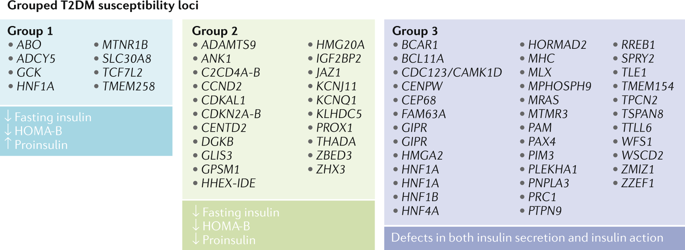当前位置:
X-MOL 学术
›
Nat. Rev. Endocrinol.
›
论文详情
Our official English website, www.x-mol.net, welcomes your feedback! (Note: you will need to create a separate account there.)
Insights into pancreatic islet cell dysfunction from type 2 diabetes mellitus genetics.
Nature Reviews Endocrinology ( IF 40.5 ) Pub Date : 2020-02-25 , DOI: 10.1038/s41574-020-0325-0 Nicole A J Krentz 1, 2 , Anna L Gloyn 1, 2, 3, 4, 5
Nature Reviews Endocrinology ( IF 40.5 ) Pub Date : 2020-02-25 , DOI: 10.1038/s41574-020-0325-0 Nicole A J Krentz 1, 2 , Anna L Gloyn 1, 2, 3, 4, 5
Affiliation

|
Type 2 diabetes mellitus (T2DM) is an increasingly prevalent multifactorial disease that has both genetic and environmental risk factors, resulting in impaired glucose homeostasis. Genome-wide association studies (GWAS) have identified over 400 genetic signals that are associated with altered risk of T2DM. Human physiology and epigenomic data support a central role for the pancreatic islet in the pathogenesis of T2DM. This Review focuses on the promises and challenges of moving from genetic associations to molecular mechanisms and highlights efforts to identify the causal variant and effector transcripts at T2DM GWAS susceptibility loci. In addition, we examine current human models that are used to study both β-cell development and function, including EndoC-β cell lines and human induced pluripotent stem cell-derived β-like cells. We use examples of four T2DM susceptibility loci (CDKAL1, MTNR1B, SLC30A8 and PAM) to emphasize how a holistic approach involving genetics, physiology, and cellular and developmental biology can disentangle disease mechanisms at T2DM GWAS signals.
中文翻译:

从 2 型糖尿病遗传学洞察胰岛细胞功能障碍。
2 型糖尿病 (T2DM) 是一种日益普遍的多因素疾病,具有遗传和环境风险因素,导致葡萄糖稳态受损。全基因组关联研究 (GWAS) 已经确定了 400 多个与 T2DM 风险改变相关的遗传信号。人体生理学和表观基因组数据支持胰岛在 T2DM 发病机制中的核心作用。本综述侧重于从遗传关联转向分子机制的前景和挑战,并强调在 T2DM GWAS 易感位点鉴定因果变异和效应转录本的努力。此外,我们检查了当前用于研究 β 细胞发育和功能的人体模型,包括 EndoC-β 细胞系和人诱导多能干细胞衍生的 β 样细胞。
更新日期:2020-02-25
中文翻译:

从 2 型糖尿病遗传学洞察胰岛细胞功能障碍。
2 型糖尿病 (T2DM) 是一种日益普遍的多因素疾病,具有遗传和环境风险因素,导致葡萄糖稳态受损。全基因组关联研究 (GWAS) 已经确定了 400 多个与 T2DM 风险改变相关的遗传信号。人体生理学和表观基因组数据支持胰岛在 T2DM 发病机制中的核心作用。本综述侧重于从遗传关联转向分子机制的前景和挑战,并强调在 T2DM GWAS 易感位点鉴定因果变异和效应转录本的努力。此外,我们检查了当前用于研究 β 细胞发育和功能的人体模型,包括 EndoC-β 细胞系和人诱导多能干细胞衍生的 β 样细胞。



























 京公网安备 11010802027423号
京公网安备 11010802027423号